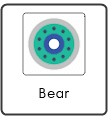PHYSICS-APPLICATION BEARING ROLLER
Women Graduates are trained with basics in Industry application from basic science Mathematics, Physics, Chemistry
Training in application Software by Industry Professional, to train others with preparation as TRAINER to empower.
Empowering areas are ACADEMIC SERVICE-ENTREPRENEURSHIP-DESIGN SERVICE-INDUSTRIES-SOCIAL ENGINEERING
AIM of this training is to get employment directly or indirectly from Industries, Government organization either state or central bodies. Also to develop or support rural industries & other application industries either as induvial or self group
APM BEARING ROLLER
Efficient method for designing non-ideal bearings - simulation instead of defining single parameters
A bearing is considered non-ideal if the errors in its manufacture cannot be neglected in the context of the problem being solved. Many important problems of contact stiffness and contact stress require that the bearing be considered precisely as imperfect. The STC APM has developed a universal method for solving contact problems, the reliability and efficiency of which have been confirmed by the results of experimental studies.
APM Bear performs a full range of verification calculations, when the output characteristics of the bearing are calculated from the known geometry of the bearing. When determining the output characteristics, original analytical and numerical approaches are used, as well as mathematical modeling methods, which makes it possible to present the results of calculating these parameters and the magnitude of their statistical dispersion in a user-friendly form (table, graph, histogram). In particular, it is possible to describe the behavior of bearings in real time using an animation procedure.
The whole complex of solutions obtained provides the user with the opportunity to visually, both qualitatively and quantitatively, evaluate the suitability of a bearing (or a pair of bearings) and, if necessary, outline ways for selecting parameters for more efficient bearings.
Efficient method for designing non-ideal bearings - simulation instead of defining single parameters
A bearing is considered non-ideal if the errors in its manufacture cannot be neglected in the context of the problem being solved. Many important problems of contact stiffness and contact stress require that the bearing be considered precisely as imperfect. The STC APM has developed a universal method for solving contact problems, the reliability and efficiency of which have been confirmed by the results of experimental studies.
APM Bear performs a full range of verification calculations, when the output characteristics of the bearing are calculated from the known geometry of the bearing. When determining the output characteristics, original analytical and numerical approaches are used, as well as mathematical modeling methods, which makes it possible to present the results of calculating these parameters and the magnitude of their statistical dispersion in a user-friendly form (table, graph, histogram). In particular, it is possible to describe the behavior of bearings in real time using an animation procedure.
The whole complex of solutions obtained provides the user with the opportunity to visually, both qualitatively and quantitatively, evaluate the suitability of a bearing (or a pair of bearings) and, if necessary, outline ways for selecting parameters for more efficient bearings.
Entering initial data
The APM Bear module is easy to use, and this can be seen in the organization of input data. All bearing dimensions can be entered manually, or you can use the database that is part of the APM WinMachine system. The database includes the standards used in Russia, at the same time it is available for editing. Accuracy parameters at the request of the user are selected using the database for a given accuracy class.
The loads acting on the bearing can be arbitrary, while the preload force can also be considered as an external load. The preload value, depending on the type of bearing, is specified either in the form of an applied axial (radial) load or in the form of radial (axial) movements.
For the case when the external loads acting on the shaft change over time, there is a specialized graphical editor with a full set of functions necessary for entering variable parameters.
Displacements and Stiffness – Key to Bearing Design
The distribution of loads on the rolling elements significantly affects the durability of the bearing. The calculation for durability is reduced to determining the operating time of the bearing until the beginning of the spalling of the raceways.
An important parameter characterizing the operation of bearing supports is the accuracy class, which is directly related to the magnitude of shaft displacements. Depending on the bearing type, these displacements can generally have axial, radial, and lateral components.
In order to study the pattern of statistical dispersion of output parameters in the APM Bear module, they are calculated for one hundred arbitrary positions of the bearing center.
The results of the load calculation also make it possible to determine a series of energy characteristics that determine the energy consumption and operating temperature of the bearing: efficiency, friction torques, frictional power losses, heat generation, etc.
Presentation of calculation results
The calculation results are presented in various ways in the form:
- tables with statistical characteristics;
- histograms of displacement components;
- spatial field of positions of the center of the bearing;
- animation of the movement of the bearing;
- graphs describing changes in the parameter by the angle of rotation of the bearing.

